#Proco Rat 2 Distortion
Explore tagged Tumblr posts
Text
How To Use - Top 5 Distortion and Overdrive Pedals
The Top 5 Distortion and Overdrive pedals you can buy easily, and just about anywhere. These are the some of the best drive tones you can purchase today. And not a boutique pedal in sight!
This list gives you what I believe are the most flexible, reliable, and readily available stompboxes. If you need a good overdrive or distortion for your guitar setup then this is the list for you and I’ve added a few basic tips to get the most out of each pedal. Ultimate Drive Tone? I have a huge collection of pedals myself and have been using pedals for over 35 years. This has given me some…
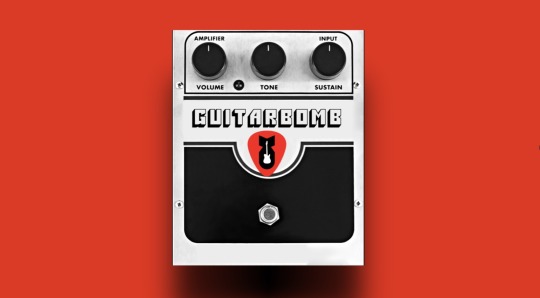
View On WordPress
#Booster#Boss#Boss BD-2 Overdrive#Boss DS-1 Distortion#Boss SD-1. Boss#diodes#distortion#fuzz#germanium diode#hard clipping#How To Use#How To Use these Top 5 Distortion and Overdrive Pedals#How To Use Top 5 Distortion and Overdrive Pedals#Ibanez#Maxon#MXR#MXR Distortion +#MXR Distortion Plus#Nobels ODR-1 BC#overdrive#pedal#preamp#ProCo#Proco Rat 2 Distortion#soft clipping#stompbox#Top 5 Distortion & Distortion Pedals#Top 5 Distortion Pedals#Treble Booster#TubeScreamer
0 notes
Text
finally!! finished the guitar pedal my dad got the kit for like a year and a half ago

i redesigned it from scratch because the construction of the original clone was annoying and i think it’s dumb that guitar pedals sometimes use reverse-polarity power and you’re just supposed to guess, so this one takes either polarity through the same jack.


photographic evidence of how this distortion pedal works! based on the Proco RAT of 70s fame, essentially we just clip the signal peaks to introduce other frequencies, which make up the distortion we hear. the FFT on my scope didn’t show much, but either i didn’t tune it right or the instrumentation is just limited here, because we can see pretty clearly the flattened peaks on the processed signal (2, 3) compared to the input (1).



i learned some things about design for manufacturing (DFM) from this project, not just from the original clone board but also from shortcomings of my own design (it turns out that’s a LOT of wires to manage in that small space). if i did it over, i’d put the pins on a 0.1” pitch grid across the board, probably use larger components, and take more care in choosing the shape of the PCB to fit the enclosure around all the hardware. I might even have split it up into a few tiny boards! just for kicks. i also probably would have soldered wires onto the kick switch at an angle, so that they’re not stressed or bent on their way to their final configurations.



the light pipe in particular was a challenge because it turned out the cap on the pipe was small enough that it would slide all the way through the hole meant for a THT LED. I could have fixed this with a washer if I had one, but I eventually hot glued a nut to the cap and let it be.

big thanks to my friends and partners including @thinkpadt530 who helped me with this! i learned a lot from them all, and definitely would not have finished without them. <3
15 notes
·
View notes
Text
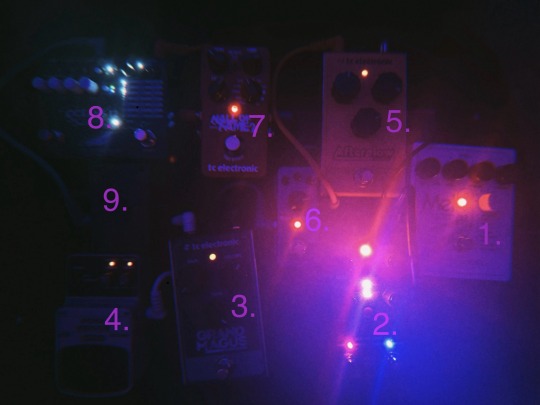

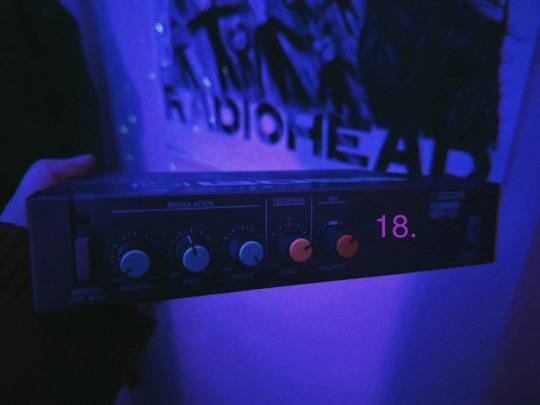
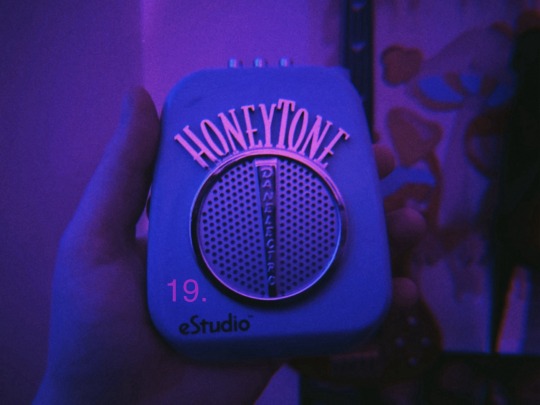
i could talk about these for HOURS, they're all my effects pedals!! i haven't fully tapped into all of them but i've been doing a lot of recording lately so i'll probably make some pretty noises with all of them some day in the near future :>
the first picture's order is all wonky because that's the order i have the pedals in the chain
1. EHX' Mel-9 (Mellotron emulator)
2. Alexander Pedals' Defender (OD/DST/FZ)
3. TC Electronic's Grand Magus (RAT similar)
4. Behringer's Noise Reducer (i use mostly as a mute when tuning)
5. TC Electronic's Afterglow (chorus)
6. Donner's Mod Square II (16 modulation in a mini casing)
7. TC Electronic's Hall of Fame 2 (digital reverb)
8. EHX' Oceans 12 (dual digital reverb/delay)
9. homemade JHS Little Black Box copy (1 setting buffer)
---not on the board---
10. TC Electronic's Sub'n'Up (octave)
11. Proco's RAT (distortion/fuzzish?) this one gets put back on the board every now and the
12. Dunlop's Crybaby (wah-wah)
13. Danelectro's Dan-Echo (echo/delay)
14. Joyo's Wow-Wah (auto-wah)
15. Donner's Echo Square
16. BOSS' ODB-3 (bass overdrive) i use this a lot when i play bass :)
17. BOSS' LMB-3 (bass limiter/enhancer)
18. BOSS' RBF-10 (rack mount flanger)
19. Danelectro's EStudio Honeytone E-15 (my dad's headphone amp from the mid-late '90s, not really a pedal but it can sorta be)
secret 20. 1-Spot Pro (power supply under the board, also not really a pedal but it's essential for the rig)
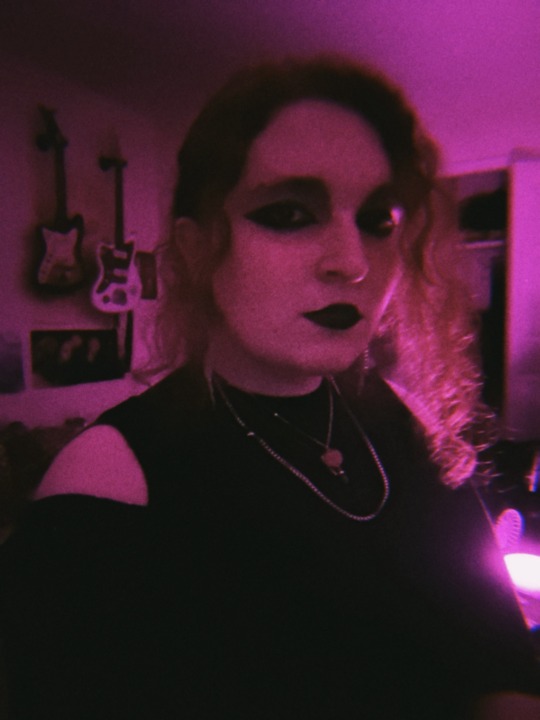
the shoegazer tap dancing on all those thangs
#dreampop#emo#shoegaze#dream pop#goth#noise#diy#trans artist#trans musician#trans music#transfem#trans woman#transgirl#transgender#queer#queer artist#electro harmonix#tc electronic#danelectro#jazzmaster#harmony#boss#effects pedals#guitar#guitar pedals#bass pedals#again don't rob me#i'd be really sad :(#too many tags#i'm sorry
12 notes
·
View notes
Note
trick or treat?
You received: ProCo RAT 2 Distortion Pedal (uncommon)

3 notes
·
View notes
Text
Last week's top 20 videos (2023 week 26)
Top 20 videos last week (June 25 - July 1)
Beetronics ? Octahive v2 ? High Octave Buzz (by Beetronics)
?DONNER?Wanna travel the space with #donner #delay #guitar #pedal (by Donnerdealcom)
Danelectro Wasabi - Delay, Overdrive, Boost, Chorus, Vibrato and Distortion Pedals (by JHS Pedals)
Explaining Guitar Effects - EPISODE 4 - Wah Pedals (by StompboxTV)
DryBell Sonic Experience - Featuring The Engine with the vintage '79 MXR Phase 45 (by DryBell)
Walrus Audio Overdrive Comparison (by Walrus Audio)
How to set up your T Rex Binson Echorec (by T-Rex Engineering)
Yet Another Pedal Demo - Marshall VibraTrem pedal (by BMC Guitar Effects)
TC Electronic Ampworx: 3 Preamp Pedals of Flexible, Full-size Sound (by Sweetwater Sound)
What?s your favorite of the EHX Big Muff Pi? #fuzz #ehx #electroharmonix #bigmuff #bigmuffpi (by Does It Doom)
Strymon Tech Corner: How To Reset BigSky, Mobius, and TimeLine (by Strymon)
Beetronics FX Octahive V2 | Guitar & Bass Pedal Demo (by Demos In The Dark)
History of Pedals | Supa Fuzz, Supa Wah, The Guv'nor, Mark I & II Series, DRP-1 | Marshall (by Marshall)
Sola Sound Tone Bender MK4 '71 ? EHX Memory Man ? N SG LTD ? JB (by Soulman Vintage)
legendary pedal meets legendary bassist! (by BassTheWorld)
Boss DSD-2 with Moog Grandmother (by The Pedal Picassos)
Beetronics Octahive v2 (by Mike Hermans)
Can THIS Delay pedal do it ALL?! TC Electronic Flashback Mini (by Budget Pedal Chap)
@musicmaker6860 PLASMA Pedal demo #gamechangeraudio #guitar #plasmapedal (by Gamechanger Audio)
LATINO JAM with PROCO RAT 1985 - PRS CUSTOM 22 - FENDER SUPERSONIC 22W (by JokeAndRazz)
Overviews of the previous weeks: https://www.effectsdatabase.com/video/weekly
from Effects Database https://bit.ly/44shdXy
1 note
·
View note
Text
Guitar Overdrive Pedal Shootout: ProCo Rat 2 Review.
Part 5 of my Guitar Overdrive Pedal Shootout series. Review of the ProCo Rat 2. Meeting a Legend. I won’t bore you with the background of this shootout, for that please refer to the other parts in the series on this site. I’d now been through the clone phase, and so far in my quest I’ve established my requirements… Organic overdrive/distortion. Transparent and flexible enough to cope with a…

View On WordPress
#Distortion pedal#Electric Guitar#Guitar#Guitar Effects#Guitar pedals#Music#overdrive pedal#ProCo Rat#ProCo Rat 2#Review
2 notes
·
View notes
Text
Why Nobody Understands the RE-20′s Preamp Bypass
The Roland RE-201's preamp was once again the topic of gently heated forum posts after Boss released two new Space Echo pedals earlier this year (the RE-2 and RE-202). On the original RE-201 Space Echo, the preamp was an analog circuit that boosted and filtered the input signal, preparing it to be written to the magnetic tape used to create the infamous echo effect. This meant that the “direct” signal had some coloration from the preamp even when the echo was not in use. The new pedals include a digital emulation of the preamp, and most forum posters seem happy that the emulation can be bypassed (as a secondary function). But these forum posts also revealed that few players seem to understand the way the preamp works on Boss’s older Space Echo emulation: the RE-20 pedal. That’s understandable, because the RE-20 has a bypass arrangement that I’ve never seen on another pedal....

The RE-20 is easily the most-used delay pedal for Thom and Jonny. During rehearsals last December, Thom had three of them spread across his pedalboards for use in his independent guitar and vocal signal paths.
Volume Controls
One must admit that the single “input volume” control on the RE-20 pedal is a bit unusual. On most pedals, the “input gain” control only has an effect when the pedal is active. That’s the reason most pedals also have “output volume” control: you can set the gain control however you like, then adjust the output volume control to match the volume when the pedal is on and when it’s off. So on a standard preamp pedal, you can crank the “gain” for some clipping, then back off the “volume” to avoid shaking the windows.
On the RE-20 pedal, the “input volume” control effects the volume even when the echo effect is turned off. This design decision has some benefits: it allows Boss to leave out the “output volume” control, making the pedal easier to use and cheaper to manufacture. It’s also reminiscent of the input gain control on the original RE-201 tape echo. The downside is that if you want to give the echos a gritty, compressed sound, you have the boost your output volume even when the echos are turned off. So if you’re carefully gain-staging your effects and how you hit your amp’s input, the RE-20 can really throw a wrench in the works. Not only that, if your input signal is boosted too much, you’ll get harsh hard clipping even when the echo effect is turned off. Boss addressed this on the new RE-202 pedal by offering a “saturation” knob that only affects the direct volume if you activate the preamp emulation. But the RE-20 pedal has other bypass oddities too...

With a loud input (such as this synth oscillator), the Boss RE20 can add some harsh hard clipping even when the echo effect is turned off. The clipping only gets more extreme as you turn up the input volume control. Many describe this clipping as “digital”, but there’s nothing inherently digital about hard clipping. Analog distortions like the Proco Rat and Marshall Shredmaster use hard clipping for an aggressive sound. However, the RE-20 pedal′s hard clipping is very different from the multi-stage transistor clipping on the original RE-201.
The RE-201′s Transistor Preamp
The on/off footswitch on the RE-20 pedal may not bypass the “input volume” control, but it does change the sound of the “direct” signal! This is what makes the RE-20 really unusual. But before we delve further into the RE-20, we should first understand more about the input stage on the original RE-201 Space Echo. On RE-201, the input passes through a transistor preamp that is always active. This is great for folks who like the preamp’s coloration: a gentle rolloff of the highs and lows, plus a bit of transistor clipping. But if you wanted to bypass the unit entirely, you’d need a separate bypass loop box.
Most folks, Jonny Greenwood included, decided to embrace the preamp’s sound and instead used a footswitch to disable the echo. A footswitch connected to the “echo cancel” jack actually stops and starts the RE-201’s motor, disabling the echo effect. In an added quirk of analog electronics, the sudden change in speed when the motor stops creates a bend in the echo’s pitch as heard on live version of In Limbo, but that’s another story (and note that “tails” on the RE-20 works differently). When the “cancel” footswitch is used, the direct signal is always passed through the input volume control and the transistor preamp, regardless of whether the echo motor is running.
And for the curious, this info is only true for the RE-201 and RE-101 Space Echo units. Roland’s later Space Echos such as the RE-301 (famously used by Brian Setzer) and RE-501 feature different preamp circuits.

Here's a simulation of the frequency response of the transistor preamp in an late-period RE-201 Space Echo with a buffer before the input (the treble basically disappears if you connect a guitar directly to a Space Echo, so most people put a buffered pedal in front to correct the impedance mismatch). On a real vintage Space Echo, the frequency response could be more dramatic if the aging capacitors haven't been replaced in the past ~40 years.

Jonny with two of his vintage Roland RE-201 Space Echo units during the recording of Radiohead’s In Rainbows (radiohead.com/library).
The RE-20′s Preamp Bypass
Boss understandably wanted to recreate the tone of the original RE-201 unit, so the RE-20 pedal includes an emulation of the RE-201′s transistor preamp. That faithfulness to the original is also the reason the RE-20 has such a gritty, tinny sounding reverb effect (whatever you think of it on its own, the reverb blends beautifully with the echo). But the engineers at Boss must also have realized that many modern players want their direct tone to be unaffected when a pedal bypassed. So when the RE-20′s echo is turned off, the preamp emulation is turned off too. Many folks don’t seem to realize this, since the volume control suggests that the preamp is always active, like it was on the original RE-201. But when you turn off the RE-20′s echo, the “direct” signal is instead passed along with minimal filtering. To sum it all up: when the echo is turned off, the signal is still buffered, and its level is still set by the “input volume” control (which can still cause hard clipping), but the coloration from the preamp emulation is disabled.
To test this, set the volume of the echo and reverb on the RE-20 to zero, and turn the effect on and off with the footswitch. It’ll depend on your setup, since a mids-heavy amp might already cut those frequencies. Even so, you should notice a some cut to the lows and highs, and perhaps a tiny dip in volume.

Here’s a the frequency response of “direct” signal through a Boss RE20 pedal. For the “Effect ON” setting, the echo and reverb volume controls were set to zero.
When the effect is turned on, the high end takes a serious hit above 10kHz. In addition, the direct volume is lowered by 0.5dB, presumably so that the overall level feels the same even when the delay signal is mixed in. In contrast, when the effect is turned off the frequency response is basically flat (there’s a reduction of 0.5dB at 15kHz, but you’d probably never notice it running through guitar cabinet). Notice that the high-end rolloff begins later than on the RE-201 preamp (at about 2kHz instead of 1kHz) but cuts the high-end much more dramatically above 10kHz.
Modern Versions
It’s worth noting that the newer RE-2 and RE-202 pedals do not replicate this behavior. Instead, the transistor preamp emulation can be turned on or off as a secondary function. And when the preamp is selected on the new pedals, it stays active even when the echo is turned off. In that sense, it’s more faithful to the original RE-201. But I find it a shame they didn’t include the RE-20’s style of bypass as an additional option, especially since they offer multiple bypass options. That said, if they did add another bypass option, nothing would beat an emulation of the motor stopping when the echo is “cancelled”! For now we’ll have to make do with the twist feature.

Here’s a bonus screenshot of Thom with a Roland RE-201 Space Echo during the Radiohead’s performance of The Bends on Jools Holland in 1995 (radiohead.com). Note that he’s running the output of the RE-201 directly into his ‘65 Reissue Fender Twin Reverb, and he has a footswitch wired up to the RE-201′s echo cancel input. This performance is pretty unusual, as Jonny was not yet using a Space Echo of his own. However, Jonny started touring with one by the next year, and Thom hasn’t performed with an RE-201 since.
13 notes
·
View notes
Text
PedalPCB 1981 inventions DRV clone
This is a build of the PedalPCB Informant, it’s a clone of the 1981 Inventions DRV, which is a great sounding evolution of the ProCo Sound Rat. I’d call this a beginner to intermediate level project. The PCB is easy to work with and well laid out with plenty of room to work. The only thing that moves this up from a beginner project is the charge pump. It’s not hard to work with but you do have be careful as these can be blown up easily, there are a few different parts to choose from, and depending on the part number you may need to solder the jumper on the back of the board.
This shares a lot with the Klon but goes further in the drive/distortion range. The DRV and Klon use a charge pump to run on 18 volts. This gives the pedal greater headroom. It also makes it a poor candidate for batteries. They both use a similar clipping architecture with diodes to ground after the op-amp, like a lot of other designs. While the diode arrangement and charge pump are similar the sounds are pretty far apart. The Klon has a deeper mid focused growl and and DRV has tighter sharper mid chunk. It’s the difference between Tom Waits and David Lee Roth.
I used a black powder coated 125B enclosure. I milled the logo and labels into the enclosure with a desktop mill.
Assembly
The PCB is east to assemble and well laid out with plenty of room to work. The pots and LED are mounted to the board which makes for little work wiring and mounts the PCB in the enclosure.
I assembled everything in the enclosure without soldering, fitted the washers and nuts on the pots and bent to LED into position, then soldered the leads on everything.
The docs provide a drilling diagram for a 125B box with the jacks at the top which is a popular arrangement and works well.
Wiring
The PCB makes the off board wiring organized and easy to implement. There are two options to choose either buffered bypass or true bypass. The true bypass option removes the effect entirely from the signal chain and the signal passes from the input to the output through a wire. In the buffered mode one of the op-amps is used as a unity gain buffer when the effect is bypassed. I chose the buffered arrangement for this build which is how the original 1981 DRV works.
Cost
Parts for this project are easy to get and common. The thing of note is the charge pump which are about $2 and can be blown if they get shorted. I’ve burned up a few in the past. It’s this charge pump the boosts the 9 volt power supply up to 18 volts.
Running at 18 volts you’ll want to use 1/4 watt resistors and make sure the caps are rated 25 volts or height.
The other parts are pretty common TL072 op-amps and mostly 10k and 100k resistors. You might have all the parts left over from a previous project!
How Does it Sound?
It sounds like ROCK! This is a total ‘80s rock machine. In some ways it has some of the character of a Klon. But the Klon has a deeper/darker mid range and goes from almost clean to heavy overdrive. The Informant/DRV goes a from distorted to really distorted with with brighter mid range and tighter bass.
Here is a video demo:
youtube
PedalPCB Informant Demo
This one is for sale on reverb check out my for sale page
PedalPCB 1981 inventions DRV clone was originally published on Super-Freq
2 notes
·
View notes
Photo

New old pedal day X 2! 87’ RAT and the Shred Master! So stoked for these! #rat #ratpedal #vintagerat #proco #procorat #marshall #marshallshredmaster #shredmaster #distortion #distortionpedal #overdrive #overdrivepedal #guitargear #gear #vintagegear #guitarpedals #guitarpedal #pedalboard #guitar #npd #newpedalday https://www.instagram.com/p/CMe0i5gMnQN/?igshid=rk78tc2ipde7
#rat#ratpedal#vintagerat#proco#procorat#marshall#marshallshredmaster#shredmaster#distortion#distortionpedal#overdrive#overdrivepedal#guitargear#gear#vintagegear#guitarpedals#guitarpedal#pedalboard#guitar#npd#newpedalday
4 notes
·
View notes
Text
Meeting Bomg, Doom-Drone Legends from Ukraine
~Interview by Billy Goate~
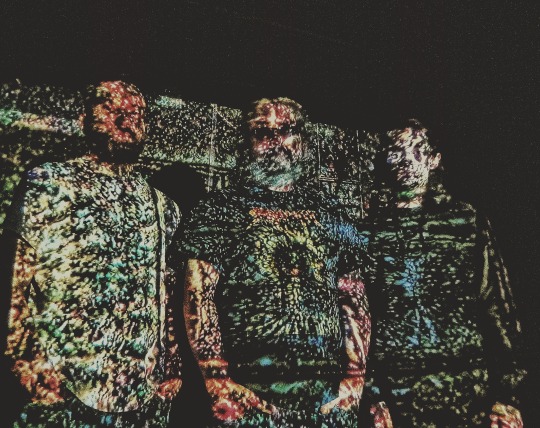
Doomed & Stoned continues our week of epic interviews with a long overdue conversation with the great Ukraine doom-drone band BOMG, who have been desamating stages and blowing out amps since 2010. During that time, Nikolay Temchenko (guitar), Yuriy Temchenko (bass), and Anton Khomenko (drums) have put out two mammoth LPs, an EP, and a split.
I first got turned on to BOMG's sound with the record 'Polynseed' (2013), which released the year that Doomed & Stoned was founded. I recommend starting there if this is your first exposure to the mighty trio from Kyiv.
Bomg have been gradually drifting in the direction of full-on drone metal, executed in their own authentic and compelling way, as we're about to discover as we drill into 'Peregrination' (2020) -- which we reviewed last year and Robustfellow has recently reissued.
Give ear...
You state that BOMG means “vagabond” on your Bandcamp page. Can you elaborate on how the name ties in with the band’s history and core identity?
It’s an abbreviation literally meaning “with no particular place of living”. Funny thing is that its’ meaning is degraded in common use (like “bum”), but when it was incepted (60s – 70s in USSR) those who were stigmatized by it were better off going elsewhere than being part of the regime, taking it as a positive. This became somewhat of a short-lived movement even. We think that despite being prone to misunderstanding in every way, it fits the overall vibe. Blessing and a curse. But frankly, the name is a secondary thing at best.
How would you describe your distinctive sound, to someone who has never encountered it before?
Basically, trying to elaborate and add to “Black Sabbath spaghettified” idea. We try to squeeze out any possible amount of low frequency, volume, distortion and effect saturation to the instruments, not necessarily designed for it. As of similarities and influences, it’s 60s-70s heavy psych, proto-metal and proto-punk, 80s - 90s continuation of it (doom metal, stoner/desert rock, sludge, drone doom), besides that – dub, ambient, prog rock, experimental music, field recordings and whatnot.
Peregrination by Bomg
Your new album 'Peregrination' is an explosive bombshell, massive in every respect. When was the concept for the album born?
The first track was almost ready in 2011, we played it at our first show. As of concept, it started to take shape somewhere in 2013-2014, most of the lyrics were written back then. Then it took years to “grow.” First, we tried to make it so each track would fit one side of LP, but it seemed kinda compressed and landed too quick. Then we decided not to confine it to any time limit but each track landed itself around 40 minutes, so we made sure it evens out like this in final recording.
Tell us about the recording process involved. We’re very curious about instruments, gear, amps, and the general studio environment in which it originated.
Each whole track was recorded live (took roughly four weeks for four tracks), then layered with two additional guitars. Synths, field recordings, vocals were added afterward.
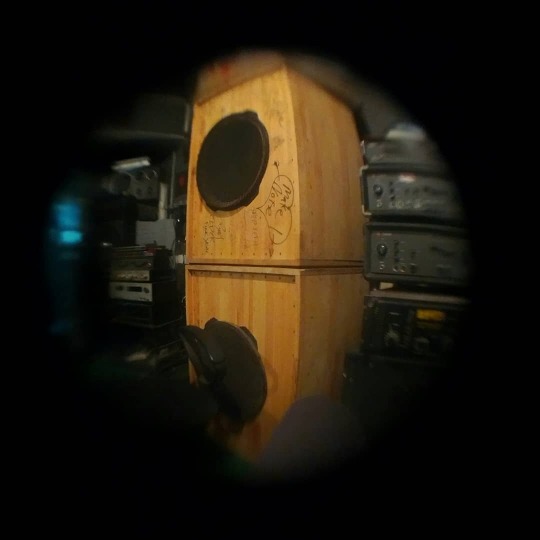
Gear: we used two Tank amps (Orange/Matamp clones) made from old soviet broadcast amplifiers and Tesla Disco 240 for guitar and bass (wish our Sunn concert bass was alive at that point, but it just burns transistors when turned on – we couldn’t find an exact schematic for it, even photos of the exact amp on the web, seems like it’s from some transition period).
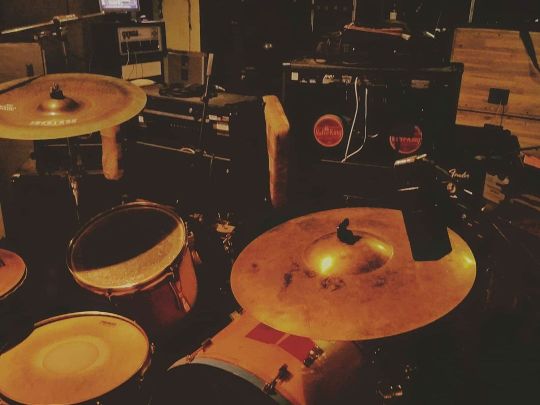
The drums are '70s Rogers 13”, 16” toms and 24” steel shell bass drum from '50s-'70s (mass-produced for political celebrations, weddings and funerals), coupled with Meinl hi-hats, Paiste Rude China and Zildjian Mega Bell.
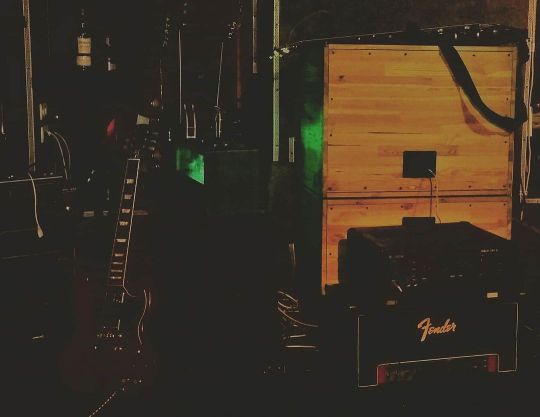
Guitars used were early '00s Gibson SG Standard, '72 Musima Eterna Deluxe and ’69 Musima Record; and ‘70 Cremona Violin bass.
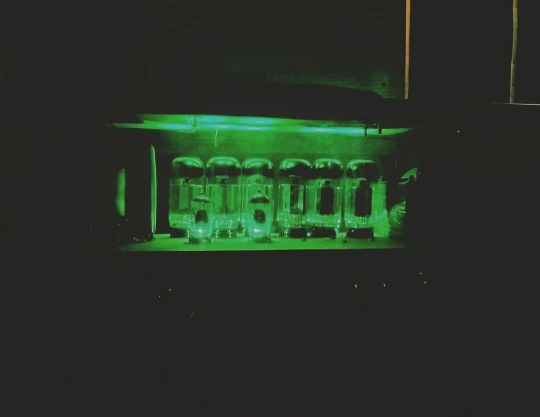
Pedals: Poltava fuzz-wah, Noname “flanger” that is actually phaser for bass; Tesla Vrable fuzz-wah (the seller told us that his uncle was under KGB investigation for just having it), Noname dist (most likely a ProCo Rat clone), Vox wah, Boss BF-2, Lel’ parametric EQ, Lel’ digital delay, Boss dynamic wah, Roland Space Echo for guitar.
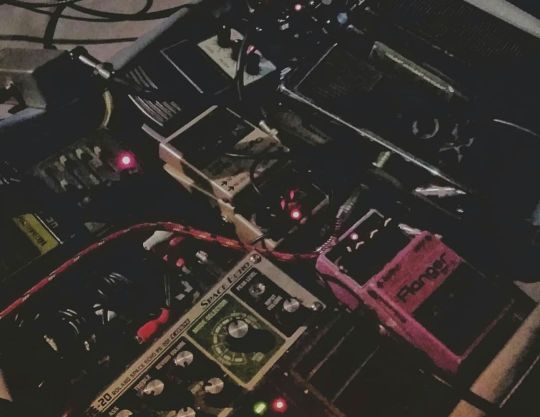
Recording equipment: Two '70s Oktava ML-19 for overheads, '50s-'60s Oktava ML15 and ML16 for room and various dynamic and condenser mics for everything else into Pro Tools, then later in mixing/mastering stage partly routed through mixer and cassette deck using beaten up cassette for analog saturation and vibrato.
Long story short, we tried to use most of the stuff we got in our studio, and at this point, it’s hard to remember every detail of the process. Referring to the environment, it is compiled of numerous weird gadgets which got to us throughout years, most of which were collecting dust somewhere for decades, and have a history (an entire topic by itself) we’re always asking for. And when used, they tell a story which then leaves a mark in recordings for sure. That was a hell of a fascinating process.
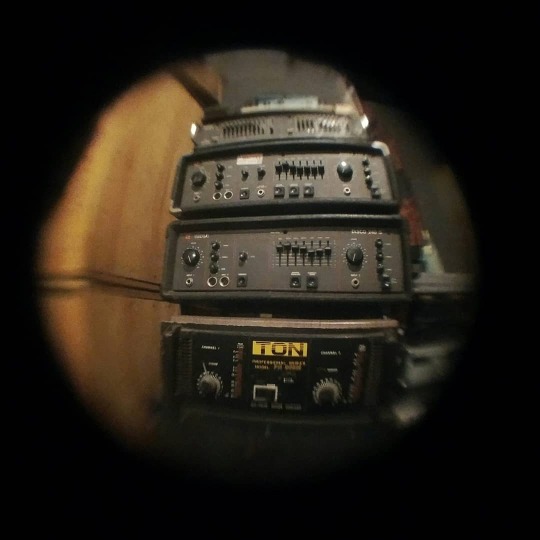
I noticed you had lyrics for each song on 'Peregrination,' but the singing doesn't seem discernable. Are there indeed vocals and, if so, how can I hear them?
Yes, there are vocals. They appear on low volume as reverberated and somewhat oscillated notes, more like presence; on high volume, you can hear words with 1-5 kHz correctly dialed in (on most audio equipment these frequencies tend to be excited, so lowering EQ at this range brings clarity), it appears as a whisper in a loud, saturated mix. Also, we added subtitles on YouTube, so you can know for sure where to find vocals. The point was to make them recognizable only with intent.
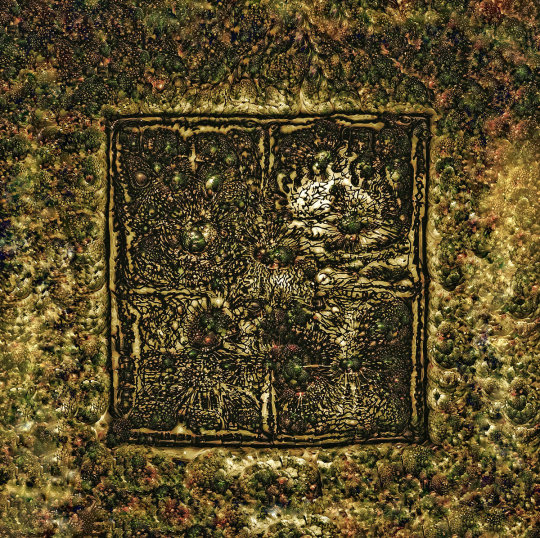
Talk about the album art. It seems there is hidden symbolism there, is that true?
It’s some sort of a window that leads to four areas, which are the visualized soundscapes to each track. There were no particular symbols, but the thing is that they fill in the picture as it is set - like a hallucination, which is often a well of meaning where symbols change and multiply interpretations, at the same time being just momentary blobs of form.
The process of making this album cover involved many iterations of drawing, running through GAN networks, editing the result to achieve the effect of a captured hallucination, close to the exact one. When hardwiring symbols directly into it, they would be eaten up by hallucinating AI. So by randomly forming a resemblance of shapes, things started popping out where they fit the most contextually - weird stuff. It’s a common thing in art to throw “open for interpretation” on everything, but this one might be.
What is the concept behind each "hobo" symbol and track on 'Peregrination'?
So, the first one means being quiet and alert, seeing what’s going on. The second one is a sign of a trolley – hopping from one soundscape to another, time travel. The third one – safe camp; it may be confusing when applied to the lyrics, but the position that is stated there facing the object is some sort of a “safe camp”, ground to stand on. The fourth one means “don’t give up”, even if applied in both meanings of this phrase to track. But the symbol references may lack context without diving into tracks.
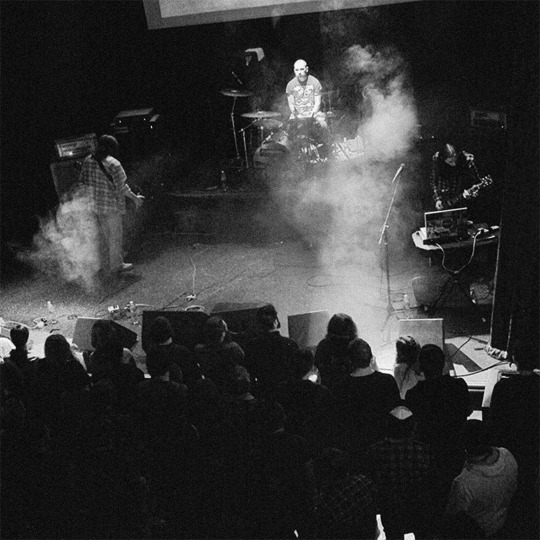
I'm sure our readers would be most happy if you were to illuminate the meaning of each of the songs on your new album.
Well, it’s like trying to create a soundtrack to some introductory ontological theories (pretty blank, sterile stuff), realizing their intensity. Here uneven-numbered tracks touch on mind ontology, even-numbered - on reality ontology. Not diving into details too much, let them hang there.
I. Electron
Peregrination by Bomg
it's no light of star it's a light of mind walking thru a dream electron shamanism
"Electron" is covering the theme of mythical perception akin to humans and the discovery that put a dent into these beliefs. Variation on a Tunguska story, mythos surrounding Tesla, how people mythologize all around.
II. Perpetuum
Peregrination by Bomg
Across desolations Caravans astray Sand covered roads Forget old ways
"Perpetuum" goes more into sci-fi territory: endless cycles of dead and born-again civilizations, the Great Filter caused by cosmic events or beings themselves, and how we just might unknowingly observe such things staring at the sky.
III. Paradigm
Peregrination by Bomg
Giant web built and set in lines It works when mind reflects Leaving us with all the fears Or letting them disappear
"Paradigm" is based around the tendency of the mind to confine itself into some set of ideas, building a higher fence while thinking it broadens the space. Thinking of one thing while it is the opposite, fear of the structure collapsing while an event like this would alleviate any sort of fear. But breaking a paradigm usually leads straight to the next one, to which the same attributes apply. And keeping this notion brings a safe distance to it.
IV. Emanation
Peregrination by Bomg
Now the opportunity is To see the universe spinning Emit structures boundless Round its' endless borders It's the very first the very last small moment In periods of endless time When the structure merge infinite To manifest as something
"Emanation" goes somewhat contrary to the second one - a reality that may be started at some point, complicates itself, and never is truly repetitive. Also thoughts on subjective existence and the point of it, maybe being an instrument of the Universe to explain it to itself. Speculation on whether or not consciousness flows from one state to another, as energy does, returning to its inception or scattering across until equilibrium, or even said results being the same thing. And the uncertainty of these things that are left to be answered while we as beings, it seems, are just left to fade away.
Follow The Band
Get Their Music
#D&S Interviews#BOMG#Kyiv#Ukraine#doom#metal#doom metal#drone#sludge#atmospheric doom#Robustfellow#Doomed and Stoned
6 notes
·
View notes
Photo






Guilhem Amplification - Scarabeo
“The SCARABEO is a Wah-Distortion pedal combining a vintage VOX 2-transistor-Fasel with a ProCo RAT distortion model 1981 rev. B, built in a leftover vintage FoXX casing.”
cred: guilhemamplification.jimdo.com
5 notes
·
View notes
Text
Audified Release MultiDrive Pedal Pro Plugin a
Audified Release MultiDrive Pedal Pro Plugin
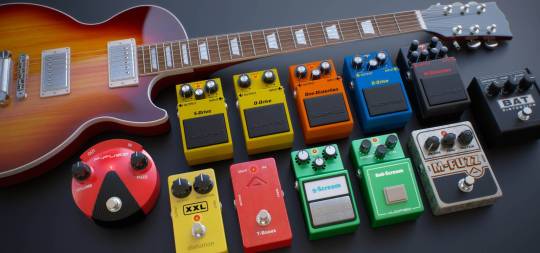
MultiDrive Pedal Pro
"Stomp it down to kick it up"
Sharpen your sound with the set of 12 legendary stompboxes.
The perfect blend
MultiDrive Pedal Pro was originated for guitarist to kick up their sound. The team of Audified engineers created the perfect simulation of the legendary pedals which every musician should have in the studio. Overdrive for power. Distortion for complexity. Fuzz for fuzziness. Boost for hearing every detail. The improved Pro version offers even better sound and features than the legendary original version which is used by thousands of musicians and studios. With 32 killer presets chosen by guitarist, the Pro gives you many options to kick up your sound!
20 years of experience
As you may check here, Audified celebrates 20 years of development under brand names DSound, Audiffex and Audified.
One of our first products was a set of Stomp Boxes. From the beginning, we were company focused on guitar software. The product was very successful, creating a base for M-Audio guitar bundles.
Now we are releasing pedals developed completely different way, using precise circuit modulation taking into account every single part of the circuits. The progress on these pedals reflects the progress of modeling methods, computer performance and 3D graphics techniques in 20 years.
All-in-One Pedal Pro
You don't have to buy dozens of stompboxes separately or download imperfect simulations. The company with more than 20 years experience on the market offers you the right mix of pedals of the true tone. Just perfect for your studio.
In our lab, we unscrewed every last screw from every modeled effect pedal and measured every part of it. Therefore you cannot tell the difference between our software simulation and the real world stomp boxes.
Looking for the right one
There are thousands of modeled stompboxes on the market of different sound, color and purpose.
Chosen by professionals
MultiDrive Pedal Pro is the bundle of the most famous and legendary stompboxes on the market. This is the third generation of our stompbox models, created with completely new modeling technology. So they simply sound perfect.
The MultiDrive stomp boxes
808-Scream is based on Ibanez TS-808 Tube Screamer, a guitar overdrive pedal, made by Ibanez. TS-808 is the first Tube Screamer, the TS808, was released in the late 1970s The pedal has a characteristic mid-boosted tone popular with blues and rock players. The "legendary" Tube Screamer has been used by countless guitarists to create their signature sound, and is one of the most successful, widely copied, and "modded" overdrive pedals in the history of the electric guitar.
9-Scream is based on Ibanez TS-9 Tube Screamer, a guitar overdrive pedal, made by Ibanez. From 1982 to 1985, Ibanez produced the "9-series" of overdrive pedals. The TS9 Tube Screamer is almost the same internally as the TS808 but the TS9 had a different output, which caused the pedal to sound brighter and less smooth.
B-Drive is based on Boss Blues Driver. The BD-2 Blues Driver delivers the creamy, yet crunchy sound associated with great blues guitar. This popular pedal provides instant access to the kind of warm overdrive and emotive distortion usually reserved for 30-year-old tube amps.
O-Drive is based on Boss Over Drive. The OD-1 is by now legendary. Artist of the 70’s was mostly using a fuzz distortion sound and the overdrive produced by the OD-1 was not typical. It was however soon accepted as the new standard of guitar sound. The OD-1 features an asymmetric circuit where the positive and negative halves of the waveform isn’t distorted equally.
S-Drive is based on Boss Super OverDrive. The SD-1 has been around for a very long time and has gone almost unchanged from its conseption back in 1981. The pedal contains an asymmetric overdrive circuit that responds very well to the player’s picking force. It produces a dynamic and smooth overdrive effect well suited to any type of rock music. The SD-1 is also popular as a booster pedal for valve amplifiers.
One-Distortion is based on Boss Distortion. The DS-1 Distortion is a true icon in the world of guitar effects. Introduced in 1978, BOSS’s first distortion pedal defined a bold new sound, delivering hard-edged attack and smooth sustain that’s been a staple of players for generations. The DS-1 is the top-selling BOSS compact pedal ever, and its original, unchanged design continues to inspire the creation of great music everywhere.
BAT-Distortion is based on ProCo RAT Distortion. The Pro Co "The RAT" is a guitar effects pedal produced by Pro Co Sound. The Pro Co RAT became very popular in the early 1980s, thanks in part to fame gained by its use by several artists. The beauty of the RAT lies in its versatility. Used as a primary distortion, it excels at arena rock rhythm tones and soaring leads.
XXL-Distortion is based on MXR Distortion+ which is a distortion pedal originally designed in the 1970s by MXR Innovations. As its name implies ""distortion,"" it's a 'distortion' (parallel clipping) but has a rather mild sound. This pedal is perhaps best known for its crunchy heavy metal sound that was featured by Randy Rhoads in his work with Ozzy Osbourne. The Distortion+ delivers everything from cool overdriven blues tones to huge '80s hard rock distortion.
M-Distortion is based on Boss Metal Zone. It delivers a very wide range of distortion sounds with 3-band EQ and strong sustain. The MT-2 Metal Zone is one of BOSS' most popular pedals. This stomp box provides some of the most over-the-top, insane distortion tones in the world—with huge mids and lows and an ultra-saturated sound.
F-Fuzz is based on Jim Dunlop Fuzz Face. The Fuzz Face is an effects pedal used mainly by electric guitarists and by some bass players. It is a stompbox designed to produce a distorted sound from an electric guitar, a sound referred to as "fuzz," which earlier was achieved sometimes by accident, through broken electrical components or damaged speakers. This particular Fuzz Face Distortion is constructed to vintage specs, featuring the original Germanium PNP transistor design for a rich, creamy fuzz sound.
M-Fuzz is based on Electro-Harmonix Big Muff Pi (π). The Big Muff Pi (π), often known simply as the Big Muff, is a fuzzbox produced in New York City by the Electro-Harmonix company, along with their Russian sister company Sovtek, primarily for use with the electric guitar. It is used by bassists as well due to the Big Muff's squeaky frequency response. Hendrix and Santana were among the first to get a piece of the Pi, and for over 40 years the Big Muff Pi has been defining the sound of rock guitar.
T-Booster is based on Brian May Treble Booster which is an effects unit used by guitarists to boost volume and especially the high end of their tonal spectrum, and was popular mostly during the 1960s. Popularized by guitarists such as Tony Iommi, Ritchie Blackmore, Rory Gallagher, Brian May, and Marc Bolan, treble boosters were used to overdrive amplifiers in order to create a more distorted yet focused sound.
https://shop.audified.com/products/multidrive-pedal-pro
youtube
Technical info
System requirements of the selected product. For some effects and applications, we have versions compatible with older systems. Please visit the Downloads page and browse the available versions if your system is older than specified here.
Mac OS X 10.9 - Mac OS X 10.13 AAX 32b, AAX 64b, AU 32b, AU 64b, VST2 32b, VST2 64b, VST3 32b, VST3 64b
Windows 7 - Windows 10 AAX 32b, AAX 64b, VST2 32b, VST2 64b, VST3 32b, VST3 64b
Price $69
https://shop.audified.com/products/multidrive-pedal-pro
#news#musicproduction#audified#plugins#guitar#stomboxes#musiccomposer#Guitarplayer#vst#au#fuzz#distortion
1 note
·
View note
Text
Rat Distortion Pedal Serial Number

After eclipsing the overdrive pedals market, Mooer released the Black Secretdistortion pedal, their take on capturing the essence of the classic ProCo RAT tonethat was so popular in the ’70s and ’80s.
Rat Distortion Pedal Serial Number Search
Rat Distortion Pedal Serial Numbers
Like the other micro pedals in the Mooer family, this pedal will fit on any pedal board with ease. Its full metal casing makes it durable and road ready, and it has a standard true bypass.
The Gear Page Apparel & Merch Shop is Open! Based on member demand, The Gear Page is pleased to announce that our Apparel Merch Shop is now open. The shop’s link is in the blue Navigation bar (on the right side), “ Shop,” with t-shirts, hats, neck buffs, and stickers to start. Here’s the direct link: www.thegearpageshop.com.

Tiny Pedal With 2 Distortions Inside

Vintage Rat Distortion Pedal Here's a vintage Rat Distortion/overdrive guitar effects pedal in good condition. Based on the serial number inside the pedal on the back of a pot. This was made in the USA in 1992, making it 23 years old! This is the original Rat design with the coveted LM308 chip.
The Pro Co RAT2 Distortion Pedal is different from any you've ever heard, with sounds ranging from a mellow twin to a raging English stack. Its smooth distortion puts extra punch in rhythm work and makes solos cut through with authority and power. The Rat2 has glow-in-the-dark luminescent control graphics and new LED status indicator for easy.
The original ProCo RAT evolved into to two different pedals, the RAT2 (a renewed standard RAT) and a new flavor called TurboRAT (more aggressive distortion based on the original Rat).
Rat Distortion Pedal Serial Number Search
The Mooer Black Secret pedal not only clones the legendary ProCo RAT2, but also the TurboRAT, so you can use both on the same pedal!
Rat Distortion Pedal Serial Numbers
You can change between the two pedals sounds thanks to a toggle switch:
Vintage: RAT clone (warm, smooth distortion)
Turbo: RAT Turbo clone (doubles the output of the vintage mode)
The Pro Co RAT Bastard (and dwarf) Twin
What’s important about this pedal is that it’s not just a cheap copy of a good-old pedal.
The thing is that the Black Secret actually sounds like an original ProCo RAT. Check out this video if you don’t believe me!
In my opinion, the pedal performs really well and, to my ears, it is almost indistinguishable from the original RAT models. Maybe the Mooer’s sound is a little bit thinner.
There are other advantages of the Black Secret over the RAT:
It uses a standard/Boss power socket while the RAT uses a 3.5mm jack
The footprint is way smaller, which is always good when building portable pedal boards
The price is also an important decision factor. The Mooer includes two pedals for less than any of the two
The only disadvantage I can think of is that the Blak Secret can’t be powered by an internal battery.
If you look for a distortion pedal that uses a RAT (or RAT-like) distortion circuit, the Black Secret is clearly the best choice. (Official Doc here)

0 notes
Text
Parentheses Fuzz postmortem
What is it
Parentheses Fuzz is a PCB from PedalPCB that is a clone of the Earth Quaker Devices Life pedal, with some mods. Originally designed as a sort of signature pedal for the Band Sunn o))).
What does it sound like?
This thing sounds lightly. It has a distortion, boost, and a switchable octave. The distortion is great, the boost works well, and the octave sounds pretty good for an analog octave effect. The controls provide volume, distortion, tone, boost, and a switchable option for the diode clipping.
What’s in the box?
Internally the pedal is based around the ProCo Rat circuit. The Octave section is similar to the Dan Armstrong Green Ringer, and the boost uses a BS170 MOST al a the ZVex Super Hard On. Not sure how they can up with the design. I wonder if Sunn o))) plugged all of these pedals together and asked EQD to make something that sounded the same or if these were just building blocks?
Costs
This is one of the more expensive projects to make. The PCB from PedalPCB is great, it’s works well, the layout is good, the pots and switch are mounted on the board. But it is also large and costs $18. That makes it the most expensive piece of the whole project by a large margin.
It is also requires 1590XX or larger enclosure. These run about $13. This and the board alone cost as much building a Big Muff in a 1950B enclosure. It also requires three switches 5 pots, and hard to get mini rotary switch. Overall I calculated the costs at about $65! Which is pretty high for a DIY project.
Besides the big ticket items some of the smaller parts are more costly and hard to get.
1590xx enclosure
Switches 3PDT x 3
4PDT mini switch
PF5102 x 3
1N34a
PCB
partcosttotal1590XX$13$133PDT Switches$3 x 3$94PDT rotary switch$4$4PF5102$1 x 2$21N34a$0.50 x 4$2PCB$18$18knobs$0.50 x 6$3total$51
here’s a code break down of significant parts.
Here is a cost break down of significant parts. There is jacks, caps, resistors, and shipping.
What about the LM308?
These are hard to get and cost about $5 a piece. Personally I dont think the choice of op-amp will affect the sound of this circuit. All of the clipping happens after the op-amp, and then there’s the analog octave. Maybe my ears have been to too many loud rock shows, I can’t hear the difference. I had some suitable single op-amps on hand so used one of those.
LM308
OP07
CA3130
Let’s talk about those transistors
The circuit uses a few transistors: PF5102, 2N5087, 2N5089, and BS170. Most of these are easy to get and I had them on hand. The PF5102 is FET and these are getting hard to find these days. Tayda had these stocked at the time I was building but they were about $1 each which is pretty high for a single transistor. Some research on the PedalPCB form found some alternative part numbers that were suggested as working. These included:
J112
J113
2N5457
2N5458
BF244
Be sure to check the pin out on any of these they may not be the same!
And the diodes
There are a few diodes of different types used here. Two of the diodes are used in the octave circuit D1 and D2. These are listed as GE, they might do better if matched. I read a few suggestions people had good results using 1N5817 diodes here.
The rest of the diodes D3-9 are used for clipping to ground and these could really be any type. Feel free to experiment and use what have on hand for these.
The last diode D100 is used for power supply reversed polarity protection and should be a 1N5817.
Results
I built three of these. The build process was made easy by the great job PedalPCB did on the board. The off board wiring is significant due to the three 3PDT switches, each of these has 9 connections. The wiring is not difficult since the box is so large.
Of the three I kept one pedal and sold the other two on Reverb with an asking price of $200. I got $200 for one and took an offer of $165 on the other. After the Reverb fees I’m keeping 92.3% minus another $0.50. So I got roughly: $336.50. I spent roughly $195! So that left me with about: $141.50. I also have Parentheses Fuzz for my trouble. There is a possibility to cut some costs here but that also takes time energy and some up front investment. I’m just doing this as hobby.
I started the work in November 2020 and sold the second pedal in February 2021. Which wasn’t too bad on turnaround time. I have a few pedals on Reverb that I listed before starting building these that are still on Reverb.
So over all it was worth the efforts but I don’t think I’m going to quit my day job any time soon. I don’t think this is going to pay the rent but it’s not just losing money either. On the contrary it’s financing the next project!
youtube
Parentheses Fuzz postmortem was originally published on Super-Freq
0 notes
Photo

Some folks say that the new made models are not right is simply untrue. The new RAT is just as good as the old ones. Folks can whine all they want about this or that chip, but in the long run there’s not a bloody thing “wrong” with a new RAT. I have both. Period. . For Sale: AGGRESSIVE SOUNDING‼️ CLEAN DISTORTION‼️ DIRT BOX‼️ EVERYTHING‼️ . Used Pedal Proco RAT 2: . Clean Boost: 1 - 9'clock Overdrive: 9 - 12'clock Distortion: 12 - 15'clock Fuzz: 15 - 18'clock 🎸🔥🔝 . Loc: Halim, Jakarta. WA: 08561 772 722 . . #procorat #procorat2 #ratpedal #overdrivepedal #distortionpedal #fuzzpedals #80srock #90srock #guitareffects #guitarpedals #guitareffectspedals #guitarpedal #joeperry #davidgilmour #pedalporn #jualefek #jualefekgitar #blur #jualefekbekas #efekgitar #efekgitarsecond #gitarisindonesia #gitarisina #jualgitarjakarta #radiohead #gitaris #guitarist #nunobettencourt #kurtcobain #jeffbeck (at Areeya House Guitar Gallery) https://www.instagram.com/p/B_apo9mlhAO/?igshid=l0o13a2xn2se
#procorat#procorat2#ratpedal#overdrivepedal#distortionpedal#fuzzpedals#80srock#90srock#guitareffects#guitarpedals#guitareffectspedals#guitarpedal#joeperry#davidgilmour#pedalporn#jualefek#jualefekgitar#blur#jualefekbekas#efekgitar#efekgitarsecond#gitarisindonesia#gitarisina#jualgitarjakarta#radiohead#gitaris#guitarist#nunobettencourt#kurtcobain#jeffbeck
0 notes
Video
youtube
Reviews ammoon Mini Guitar Effect Pedal (Distortion)Special discount ammoon Mini Guitar Effect Pedal (Distortion) CLICK HERE https://amzn.to/2XDlllp For about 1/3 the cost of a ProCo reproduction Rat, I get a mini pedal with a switch to go from vintage to modern versions of the Rat distortion sound. I bought this as I've been writing more thrash/black metal lately & was leery of the quality, but upon receiving it was pleasantly amazed. The tone: I've been lucky enough to play an original and some reproduction Rat pedals & this is the same biting sound. Played through a crappy Peavey 10-watt, a Fender Princeton 110, a Sunn Beta head with a Randall slant 4x12 or into my Line 6 Pod with headphones on, it sounds great. Of the two settings, "Vintage" is a little fatter & slightly quieter while "Turbo" is a bit louder and slightly hotter in the midrange.Physical: The housing is seriously rugged, which is good as I'm about 180lbs before putting my boots on & I stomp hard on pedals. It fits in the palm of my hand, which is good for pedal board space but means it has no 9v compartment. However, the manufacturer also sells a $10-15 multi-head pedal cord for plugging in a whole board worth. That's about the current price of two 9v where I live. The controls are straight forward and placing the switch at the top left of the face was great as it's easy to access. Mine has a blue LED indicator which is BRIGHT (as shown in the video). It actually is a bit blinding if I look straight at it indoors, so I have my tone dialed in beforehand. I thought there was an issue with the unit I got due to the volume difference so I took it to my local repair guru, Paul at Webbs Bywater Music in NOLA. He took a moment to find a connection that came loose & then proceeded to geek out on the internals. This design has fully discrete components, meaning you can swap out or modify parts if you want, but best of all it has the coveted LM308 OpAmp chip installed. If you want a different chip, you can pull it off the board and swap in about 2 minutes. Paul's now looking into stocking these, he was so impressed.All in all, I love this. My only qualm was that when I thought I might have to return it, the company replied that due to shipping & tariffs they suggest I keep the pedal and either sell it locally or trade it but they would give me a discount on my next purchase. Meh, cost of doing global business....in the end, I still think I won out. I bet ~$25 plus a 2-3 week wait & not only kept from having to spend around 3x that but also discovered a new source of high quality & affordable gear. I'll definitely be buying from them again. Distortion guitar effect pedal with true bypass switch. Mini size, durable zinc-aluminium alloy body. Supports classic rat distortion and T-turbo rat distortion. With tone(Filter), gain(Dist) and volume adjusting knobs. 100% analog signal path, ON/ OFF LED indicator light. Unbox and reviews ammoon Mini Guitar Effect Pedal (Distortion) Specifications: Material: Zinc-aluminum alloy Signal Input: 1/4″Monaural Jack Signal Output: 1/4″Monaural Jack Power Supply: DC 9V Item Size: 3.5 * 9 * 3cm / 1.4 * 3.5 * 1.2in Item Weight: 147g / 5.2oz Package Size: 6.2 * 11.5 * 6cm / 2.4 * 4.5 * 2.4in Package Weight: 185g / 6.5ozNote: The power adapter is not included.Package List: 1 * Effect Pedal Reviews ammoon Mini Guitar Effect Pedal (Distortion)
0 notes